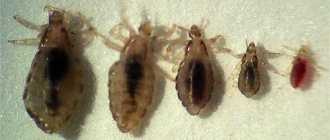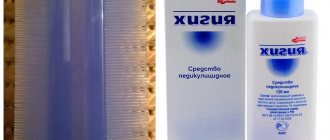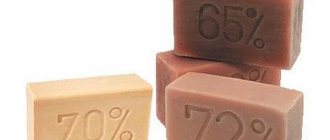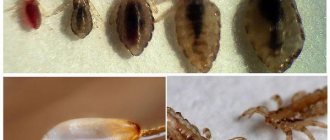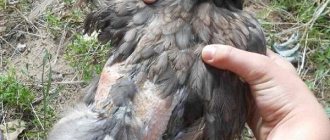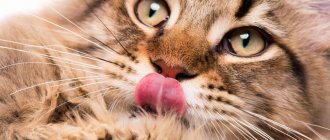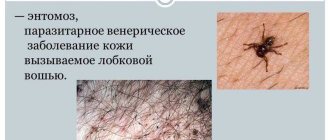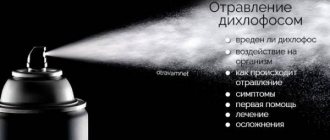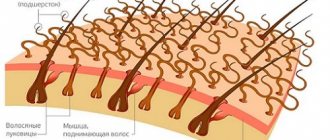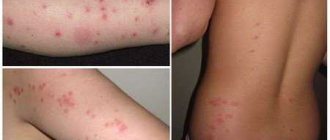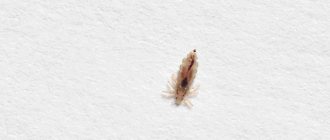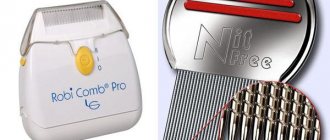A large number of hygiene and cosmetic products suitable for humans are still widely sold. But even they cannot guarantee one hundred percent protection against parasite invasion. Lice even appear in people who wash their hair and body every day. This doesn't matter much. Pediculosis develops more often in children; they are at risk. Adults become infected from them.
The main reasons for the appearance
The main reason for the appearance of lice is transmission from an infected person.
When thinking about where lice come from, you should remember that they are ectoparasites (external), and only humans can act as their carrier. It is impossible to catch lice through food or animals.
The main causes of head lice:
- the person does not observe basic rules of personal hygiene and has a low cultural level;
- a healthy person comes into close contact with those who are already infected with head lice;
- home conditions are completely unsanitary, which contributes to the rapid spread of such parasites;
- a person has a large number of sexual partners, which increases the likelihood of contracting lice pubis;
- close contact of children with carriers of the disease in children's educational institutions, educational institutions, recreation centers or playgrounds;
- general use of hats and other individual items of clothing or household items that may contain nits from a person infected with head lice;
- an adult can become infected when visiting public baths, saunas or using sun loungers, towels and other items that have not been properly disinfected;
- visiting hairdressers or beauty salons where basic hygiene rules are not followed;
- frequent business trips that require long stays on trains, as well as accommodation in hostels or hotels;
- regularly moving around the city in crowded public transport;
- crowded queues or public cloakrooms in large public places;
- swimming in pools or still natural bodies of water.
If lice are transmitted from person to person, then the explanation of where the nits come from is somewhat different. Nits are lice eggs. An adult lays about 4 eggs every day. Nits are attached to the hair using a special excretory secretion. It hardens when exposed to air, allowing it to adhere firmly to the hair. After the bite and the appearance of nits on the hair, the period of time may vary.
Based on the location of nits on the hair, the approximate time of infection can be assumed. The louse lays its eggs as close as possible to the roots of the hair (1 cm). As hair grows, it spreads over the scalp. The duration of larval development is 1-2 weeks. Hatched individuals are similar to adults, but differ in small size - up to 1 mm. Over the course of a week, they experience 3 molts and become sexually mature lice.
The main myths about lice
Despite the study of the disease, pediculosis is still associated with some myths. They do not have the slightest basis.
Myth 1. Animals carry lice. Pets, cats and dogs, have their own parasites, but you cannot get them from your pets.
Myth 2. Lice can appear from stress. Lice are parasites that can pass from one person to another. In other words, infection occurs under the influence of an external lesion. Stress does not play any role in the infection and spread of lice.
Myth 3. Only asocial individuals have lice. To become infected with head lice, one close contact with a person you know is enough. The parasite does not choose its habitat based on the external cleanliness or dirtiness of the hair, because the most important thing for it is access to food.
Myth 4. Daily hair washing prevents infection Even timely care and compliance with hygiene rules are not guaranteed protection against infection. Regular shampoo will not be able to cope with such parasites; special products are needed for this.
Myth 5: Lice can jump on you. This myth is associated with poor knowledge of the appearance and characteristics of the insect. Lice cannot jump or fly, but are capable of moving quickly. Infection occurs through head-to-head contact.
Myth 5. Lice are a shame. Indeed, pediculosis is a very unpleasant disease that you want to quickly forget about. But at the same time, you don’t need to blame yourself for being careless. Absolutely anyone can become infected.
Mechanism of infection by head lice
Many people would like to know where lice on a person’s head come from and what is the mechanism of infection. Lice do not jump or fly, they only run. Therefore, lice infection most often occurs through direct contact between people. Head lice can travel between people's heads through their hair. Those with long and thick hair are at particular risk.
It may take 1-3 weeks from the moment the first specimens enter the head of a healthy person until the first signs of head lice appear. Once on a new owner, the louse, with the help of its paws, firmly attaches itself to the hair and begins to establish life in new conditions. The parasite feeds on human blood. It obtains food for itself by piercing the host's skin with its proboscis.
The salivary glands of louse produce a special enzyme that digests blood, but does not allow it to clot. Small bruises remain at the bite sites, which cause severe itching for the lice owner. The female lays eggs and attaches them to the hair so that they are not washed off by water. After some time, new lice are born from the nits.
Differential diagnosis
The spread of lice has similar symptoms to other diseases. Therefore, it is important to make a differential diagnosis in a timely manner in order to begin quality treatment:
- Dermatitis
. The condition develops against the background of the spread of an allergen and nervous tension. If, before the formation of inflammatory processes on the skin, a person has been in contact with the causative agent of lice, he begins to become very nervous. Therefore, red spots appear on the skin, even in the absence of lice. - Scabies
. This is a disease with which pediculosis is often confused. Active itching forms on the skin, but it is caused by another parasite. This is a subcutaneous mite that penetrates under the epidermis. But abundant bite marks and wounds will not develop on the skin. - Psoriasis
. This is an incurable disease characterized by the appearance of white spots and severe itching. It forms in waves. People believe they get lice from scratching their skin.
To accurately determine the diagnosis, consult a doctor. For example, a therapist or an infectious disease specialist.
Transfer methods
How lice are transmitted from person to person:
- Public places. They are the most potential risk areas. A striking example of how you can become infected with lice is in child care institutions. Schools and kindergartens often become hotbeds of outbreaks of head lice in children.
- Water. A liquid medium can also be a source of infection, since lice are able to maintain their vital activity in it for some time. It is quite possible to pick up blood-sucking parasites in swimming pools or a rural lake where the water is stagnant.
- Close contacts. The appearance of lice on the head is possible through close contact between people. Kissing, sex, children's group games in educational institutions - all this can provoke infection with parasites.
- Insufficient level of personal hygiene. Lice can definitely appear in those who do not adhere to basic rules of personal hygiene and live in unsanitary conditions.
- Personal belongings of infected people. Personal items belonging to those who suffer from head lice may contain lice or nits and therefore pose a great danger to healthy people. If you use the patient’s personal belongings, the risk of infection increases significantly.
Some also wonder whether lice are transmitted from animals. No, the transmission routes for head lice do not include this method. Ectoparasites do not have wings and, unlike fleas, are not able to jump. They can only crawl from the hair or clothing of an infected person onto a healthy person through direct physical contact.
Treatment methods
The earlier diagnostic methods are carried out, the easier the therapy will be for the patient. It is important to eliminate the pathogen in a timely manner to prevent cosmetic defects and other complications. Therapists recommend using an integrated approach in the fight against head lice. The main directions of treatment have been developed.
- Traditional methods
. These are minor techniques for treating head lice. They are aimed at eliminating irritation and activating regenerative processes. Methods have been identified that can eliminate the lice themselves, but the procedures can be dangerous for humans, take a lot of time, and require repeated use. For example, alcohol compresses, kerosene treatment. Many of these techniques cause itching, allergies, and discomfort. They worsen the condition of hair and skin. Therefore, therapists and pediatricians recommend using traditional techniques. - Pharmacy products
. There are many shampoos, lotions, and creams that instantly destroy the pathogen. They cover them with a film, penetrate the internal structure of the body of lice, and destroy them. Most drugs are based on permitrin. This is the active component isolated in European countries. Thanks to the product, you can get rid of pediculosis in 1 day.
Many therapists and pediatricians recommend Leisner shampoo. This is a cosmetic product that is used to treat the head of an affected person. When using it, side effects rarely occur, mainly due to individual intolerance. It is enough to apply the drug for 10 minutes, then rinse thoroughly with water. There will be no traces of adults or eggs left. The active component spreads to parasites, destroying them from the inside. After washing off with water, the lice drown and die. Additionally, nits are peeled off from the hair.
Unlike other drugs, after using Leisner you do not need to use a special comb. It is enough to comb with a regular comb.
A special feature of the shampoo is its gentle composition. It contains no toxins or poisons. It has hypoallergenic properties. Therefore, treatment can be carried out for children or adults. The nits will be completely destroyed.
What caused this misconception?
There are several facts that allowed such a fiction to gain such great popularity.
The insects are small in size, so not everyone can notice them. Because of this, many people believe that if parasites are practically invisible in the hair, then they cannot be detected under the skin.
The similarity of the symptoms of scabies and pediculosis is the presence of similar irritation and continuous itching. If, with such symptoms, lice are found on the head, then they are automatically considered the culprits of the disease.
The causative agent of scabies is microscopic in size and cannot be seen with the naked eye. And in order to have a logical explanation, the subcutaneous parasite was invented.
Modern science has studied both scabies and lice quite well. And she made an unequivocal conclusion that one has nothing to do with the second.
What is the best product to buy?
It is more common to use shampoos, but the concentration of active ingredients in them is often lower than in sprays and lotions, and several treatments may be required. The use of the spray requires outside help (someone must treat the victim’s head while he sits with his eyes closed, while protecting the respiratory system from the smallest drops of the drug). In addition, asthmatics and allergy sufferers should not use sprays.
Lotions and ointments are the strongest of the options presented, so they are not recommended for children, people with sensitive skin or poor health.
Table 1. Popular pharmaceutical products for lice and nits
Shampoos Sprays Lotions, concentrates Creams and ointments
"Pedilin" Parasidose ("Parasidosis") "Hygia" Lice Guard "Nyuda" "Para Plus" "Paranit" "Full Marks" (Russia) "Pedikulen Ultra" (Russia) "Medifox" "Foxilon" "Benzyl benzoate" "Avicin" "Medilis Super" "Nittifor" (cream) "Benzyl benzoate" (ointment) "Nix" (cream)
Special cases
Treatment of head lice in children raises the most questions
The main rule here is caution. If your child has lice, ideally you should consult a doctor (he will prescribe the most appropriate remedy) and notify the school nurse
You can independently choose a drug that can harm a child’s delicate skin, and by hiding the fact of infection from employees of an educational institution, you increase the risk of re-infection: the child will be treated, return to school or kindergarten, where the parasites that he “shared” a couple of weeks ago will again spread to him " with classmates.
For the treatment of children, it is advisable to choose drugs that do not contain insecticides, but act “mechanically” - for example, due to viscous dimethicone. When choosing a product, be sure to look at the instructions - age restrictions, contraindications, and composition features are indicated there.
What to do with lice on long hair
A simplified treatment option has not yet been invented: you will also have to treat the scalp and hair along the entire length with anti-pediculosis drugs, and then carefully, strand by strand, comb out the parasites with a fine comb.
The procedure will cost a pretty penny, because you will need a much larger volume of the active product than for those with short hair. But, no matter how great the temptation to save money is, you shouldn’t use dubious cheap products: ruining the hair that you’ve been growing for several years will be much more offensive than spending additional money on your own health.
Step-by-step destruction of the parasite
So, lice was confirmed. Parents have a reasonable question: how to deal with it? There are two options:
- age-appropriate medications;
- safe traditional methods.
The final choice is made by mothers and fathers themselves. In any case, the steps for removing nits will be the same.
What do we have to do:
- Select a product and read the instructions carefully.
- Wet your hair with warm water.
- Apply the product carefully, avoiding contact with eyes.
- Distribute evenly over the entire length.
- Put a plastic bag on your head and note the time (according to the instructions).
- Rinse your hair. First with running water, then with shampoo.
- Comb your hair with a special comb. You can use a dark towel and comb out the pest over it.
- Allow hair to dry naturally. Under no circumstances should you dry them with a hairdryer.
- Do not wash your hair for about 5 days.
This procedure will need to be carried out at least twice.
It will be useful for you to read the following articles on the topic: how to win the war against parasites: nit remedies for children; an unpleasant neighborhood: how to remove nits from a child.
The course of treatment lasts at least 10 days. Depends on the chosen method. On average, the procedure for destroying nits is repeated on days 8, 15 and 22.
If the product does not help the third time, it needs to be changed. It is not recommended to use several methods at the same time.
ATTENTION! Young children are strictly prohibited from using medications containing chemicals. Thanks to modern and proven methods, today nits do not pose a big threat
The best treatment is disease prevention. Parents are advised to teach their children to adhere to basic hygiene, that is, not to use other people’s combs, towels and other personal items. Use prophylactic agents as needed
Thanks to modern and proven methods, today nits do not pose a big threat. The best treatment is disease prevention. Parents are advised to teach their children to adhere to basic hygiene, that is, not to use other people’s combs, towels and other personal items. Use prophylactic agents as needed.
Signs of lice
The main symptom is itching of the scalp, which gets worse at night. Due to itching, the sick person begins to scratch the skin vigorously. This can lead to secondary infection. Due to the inflammatory process, skin irritation and the entry of foreign proteins from the parasite's saliva into the human body, enlargement of the lymph nodes and the appearance of fever are possible. Even small wounds on the body that occur when the louse bites through the skin and feeds are gateways for infectious pathogens
Tips for preventing lice
All of Komarovsky’s advice on pediculosis converges on the need for regular examinations as a preventive measure. By checking your child's head monthly, or better yet weekly, you can detect parasites in a timely manner and begin to fight them.
On a note!
The inspection should be carried out in a well-lit room and with a magnifying glass. You need to focus your attention on the area of the back of the head, forehead and temples.
